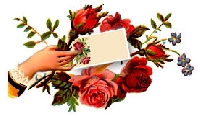Laura's Old-Fashioned Calling Cards
Launch gallery slideshow

| Group: | The Hundred Acre Wood |
| Swap Coordinator: | thehappyhoneybee (contact) |
| Swap categories: | Books Card Making Paper Crafts |
| Number of people in swap: | 11 |
| Location: | International |
| Type: | Type 3: Package or craft |
| Last day to signup/drop: | March 16, 2011 |
| Date items must be sent by: | April 6, 2011 |
| Number of swap partners: | 1 |
| Description: | |
|
Welcome to Mr. Hopp's Printing Service! There's no need to plunk down your quarter for a beautiful set of "name cards" as Miss Laura Elizabeth Ingalls did, since your dear friend and swap partner will send you a set instead. For this swap, you will create 1 dozen calling cards featuring your partner's full name, inspired by the ones exchanged by the young ladies and gents in Little Town on the Prairie. The cards may be made using images you've created, classic illustrations, vintage clip art, etc, and they should be in an old-fashioned, 18th, 19th, or early 20th century style. Most vintage calling cards had very little information on it, usually just the bearer's name, but for this project feel free to add a bit more text if you wish--but no address, please, as these would only be included on business cards. Have fun with the language and design, which will hopefully reflect the genteel spirit of the swap. Make sure your partner's name is correctly spelled! Please send your partner a minimum set of 12 cards printed out on quality card stock of your choice. Most business card templates are sized around 2" x 3.5" but you're free to decide what works best for you. What will you do with a calling card, you might ask? They make very pretty gift enclosures or swap cards, and of course, you might also meet a dashing young man with a matched pair of Morgans that you might want to trade them with one day. ;) More general information about the fascinating history of calling cards, as well as great ideas for content and design, can be found below. The Gentleman's Guide to the Calling Card Although calling cards have existed around the world for hundreds of years, they became a particularly important part of social etiquette during the 19th century in Europe and North America. Visitors who called upon a home would bring a card engraved with their name, which would be presented to the house servant upon arrival. The servant would give the card to his master or mistress, who would then decide whether or not to receive the caller. Either way, the cards were kept piled high on a silver dish in the foyer, on display for all who visited the home to see--with only the most fashionable names on top, of course. By the time these "new-fangled name cards" became all the rage where Laura lived in De Smet, South Dakota, the cards and presentations and exchanges were much simpler, of course, but the idea behind them was very much the same. | |
Discussion
Leave a Comment
You must be logged in to leave a comment. Click here to log in.
- Info:
- Home
- |
- About
- |
- Forum Rules
- |
- Terms of Use
- |
- Press
- |
- Advertising
- |
- Blog
- |
- Graphics & Stuff
- Help:
- New User Info
- |
- FAQ
- |
- Group Info
- |
- Glossary
- |
- Forums
- |
- |
- Contact Admin

